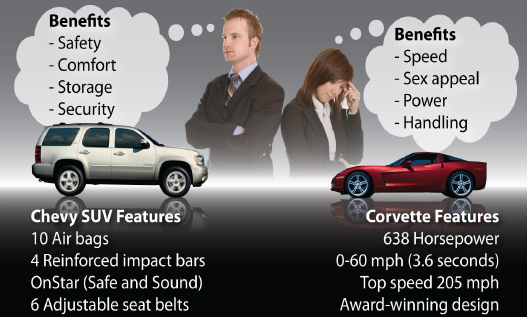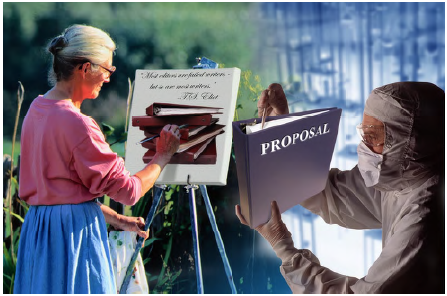
How to Create Great Proposal Themes (Part 2): Features and Benefits
- 1.How to Create Great Proposal Themes
- 2.What’s a Proposal Theme and Why is it Important? (Part 1)
- 3.How to Create Great Proposal Themes (Part 2): Features and Benefits
- 4.How to Create Great Proposal Themes (Part 3): The Proof is in the Pudding
- 5.How to Create Great Proposal Themes (Part 4): A Method for the Madness
- 6.How to Create Great Proposal Themes (Part 5): Who You Gonna Call?
- 7.Telling Your Story: Compliant and Compelling Proposal Themes that Win
Theme statements link customer benefits to the unique features of your proposal.
In Part 1, we explored the definition of a theme and the benefits of theme development in telling a compelling proposal story that scores well with evaluators. Part 2 takes a closer look at two primary components of winning proposal themes: features and benefits.
The development of proposal features and benefits is a key part of solution development and the critical first step in developing proposal themes. Most proposal teams use established methods and templates including storyboards, module plans, work packages, or some other form of pre-draft deliverable to provide a process and structure for feature and benefit development.
However, despite providing proposal teams with what might appear to be clear feature and benefit definitions, directions, and examples, many writers and subject matter experts either ignore them completely or simply don’t understand what is required. At best, features are listed as benefits (and vice versa). Or worse, the features and benefits are so vague and generalized that they fail to achieve the desired resultto provide evaluators with compelling reasons to select your company.
What happens next is predictable. Time pressures force the team to start writing before themes are sufficiently developed and the entire proposal process begins to unravel. Understanding proposal themes—and the features and benefits that comprise them— is a big step toward efficient and effective proposal development.
Features Highlight What’s Important to You
Features are easier for proposal teams to identify because they are all about their product or service. Proposals can go on and on about features with little or no knowledge of the customer.
One of the most vivid everyday examples of a feature ‘deliverable’ is a simple car window sticker commonly displayed on the driver’s side of a new car. Window stickers highlight the most important characteristics of the vehicle such as equipment (ABS brakes, air bags, traction control, OnStar); specifications (4 cylinders, 2-wheel drive); the EPA city/highway gas mileage; and the price.
This simple sticker saves consumers significant time and effort otherwise required to read the owner’s manual, or perform manual inspections/tests to determine how this car compares to other cars. Can you imagine having to drive the car on the highway and in the city making detailed notes and calculations in order to calculate gas mileage?
The features you develop for your proposal serve the same basic function as the window sticker. Proposal features describe the characteristics of your solution, e.g., type of technology/tools, methodologies, processes, performance levels, number and experience levels of key personnel, and a host of other management, technical, past performance, and cost characteristics. Whereas features are all about what’s important to you (window sticker), benefits are all about highlighting what’s important to your customer.
Benefits Highlight What’s Important to your Customer
Most proposal teams forget that although features are important, what customers really care about are benefits. Benefits are aspects or advantages of the feature that typically solve customer problems in some way. For most proposals, this means increased efficiency, reduced cost, reduced risk, higher performance levels, or some variants of these. The most effective benefit statements address both explicit (specific evaluation criteria) and implicit customer problems, issues, and concerns (hot buttons).
Most car salespersons are generally good at sizing up their customers as soon as they walk in the door and know which car features align best with customers’ benefits to make the sale. A stereotypical example using a car dealership analogy best illustrates this point.
A single, well-dressed, high-income, male drives into a Chevrolet showroom in a 10-year old, yellow Corvette. The salesperson spots him and immediately ponders a short-list of likely customer benefits (power, speed, design/sex appeal). In his mind, the salesperson starts linking features of the new Corvette models he has on the lot (horsepower, 0-60 mph statistics, vibrant colors, and motor trend design awards). Sounds like a done deal, right?
But what if the salesperson knew that the man was a stay-at-home ‘soccer’ dad and was borrowing his wife’s car to drive to the dealership? What dad really wants are safety, comfort, storage, and security. You can almost picture the salesperson’s head begin to swirl as suddenly a new set of features (airbags, reinforced impact bars, OnStar, and adjustable seat belts) are required to address safety benefits that are quite different from the ‘need for speed’.
The same stereotypical story could be told about a woman driving up to the dealership in a mini-van looking for a new car. But what if the woman was Danica Patrick—a famous NASCAR driver? Would the features of a new Chevy mini-van be interesting to someone looking for horsepower, speed, and award-winning design?
Themes Link Benefits with Features to Communicate Solutions
Proposal professionals aren’t in the business of selling cars, but the underlying principals of features, benefits, and the relationship between these two is the same in our profession. The proposal theme provides the connection between what’s important to a customer (benefit) and what’s important to you (feature). The proposal team challenge is to devise an effective and efficient way to identify customer benefits (explicit and implicit), to link these benefits to quantifiable features, and to communicate compliant and compelling solutions to customers in a way that is easy to evaluate.




